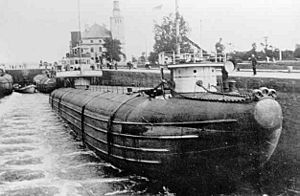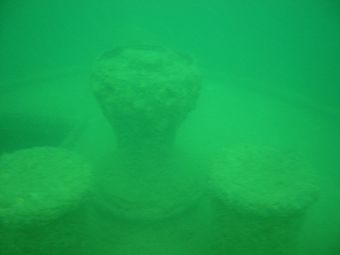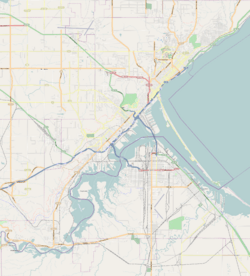SS Thomas Wilson facts for kids

Thomas Wilson in Soo Locks with two consort barges
|
|
Quick facts for kids History |
|
|---|---|
| Name | Thomas Wilson |
| Builder | Alexander McDougall; American Steel Barge Company |
| Yard number | Hull No. 119 |
| Laid down | November 7, 1891 |
| Launched | April 30, 1892 |
| In service | 1892–1902 |
| Fate | Sunk in a collision with the George Hadley |
| General characteristics | |
| Class and type | Whaleback freighter |
| Tonnage | 1713 gross, 1318 net |
| Length | 308 ft |
| Beam | 38 ft |
| Draft | 24 ft |
| Propulsion | Two Scotch boilers, 160 psi, One triple-expansion steam engine powering one propeller |
|
Thomas Wilson (Whaleback Freighter) Shipwreck
|
|

Capstan and bits on the stern end of the cabin deck
|
|
| Location | 7/8 of a mile outside the Duluth Harbor entrance, Duluth, Minnesota |
| MPS | Minnesota's Lake Superior Shipwrecks MPS |
| NRHP reference No. | 92000844 |
| Added to NRHP | July 23, 1992 |
The Thomas Wilson was a special kind of cargo ship called a whaleback freighter. It was built in 1892 and sailed on the Great Lakes, carrying things like iron ore and grain.
Sadly, the ship sank on June 7, 1902. It crashed with another ship, the George Hadley, just outside the harbor of Duluth, Minnesota. Today, the wreck of the Thomas Wilson is still a great example of a whaleback ship. It also helped change how ships operated in the Duluth harbor. The remains of the ship were added to the National Register of Historic Places in 1992.
Contents
What Was the Thomas Wilson?
The whaleback ship design was created by Captain Alexander McDougall. He wanted a ship that could carry heavy loads like iron ore or grain across the Great Lakes without costing too much.
How Was the Ship Built?
The Thomas Wilson was powered by a steam engine. This engine got its steam from two coal-fired Scotch boilers. The engine then turned a single propeller, pushing the ship through the water.
The ship's body, called the hull, was made from strong steel plates. These plates were double-riveted to steel frames. The front (bow) and back (stern) of the ship were shaped like cones. The middle part of the hull was shaped a bit like a cigar.
Ship Dimensions
The Thomas Wilson was quite large for its time:
- It was 308 feet (94 m) long.
- It was 38-foot (12 m) wide (this is called the beam).
- Its cargo area (the hold) was 24-foot-deep (7 m).
A unique feature of whaleback ships was their hatches. These were openings on the deck where cargo was loaded. Unlike most ships, the Thomas Wilson's hatches had no raised edges (called coamings). They were flat with the deck and simply bolted down. This design was supposed to help waves wash over the deck easily.
The Day the Ship Sank
On June 7, 1902, the Thomas Wilson left the Duluth harbor. It was carrying a load of iron ore from the Mesabi Range. The weather was clear and calm, so the hatches were still open.
At the same time, another ship, the George Hadley, was heading into the Duluth harbor. It was a wooden steamer weighing 2073 tons. A tugboat, the Annie L. Smith, told the George Hadley to go to the Superior harbor instead. This was because all the coal docks in Duluth were full.
The Collision
The captain of the George Hadley quickly turned his ship to the port (left side). He did not notice the Thomas Wilson or blow the required whistle signals. The captain of the Thomas Wilson saw the Hadley's movements. He was worried about hitting the bottom if he turned left, so he ordered an immediate turn to starboard (right side).
But it was too late. The Hadley hit the Wilson near the back of the ship. The Wilson rolled over to its left side, then righted itself. But it quickly began to sink from the front. In just three minutes, the entire ship was underwater. Nine of the twenty crew members sadly drowned. The ship and its cargo were worth about $207,000 at that time.
New Rules for Ship Safety
Because of this terrible collision, new safety rules were put in place for the Duluth harbor:
- Ships cannot leave the harbor with their hatches open.
- Ships must not pull away from another ship right after a collision.
- Pilots (who guide ships) must always point out other ships to the captain before carrying out any order.
- All ships must have signal systems to warn everyone on board about danger.
The Shipwreck Today
The Thomas Wilson now rests in 70 feet (21 m) of water. It is less than a mile outside the entrance of the Duluth Ship Canal. The back part of the ship is mostly complete. However, a large part of the middle section of the hull is broken. This happened because other ships dragged their anchors through the wreck over the years.
The inside of the ship is mostly still intact. Not many items have been taken by divers. In 1992, the wreck was added to the National Register of Historic Places. It was recognized for its importance in engineering and maritime history in the state.
Images for kids






